There is no doubt: alternative motorization solutions are a must from ecological, fiscal, and cost dimensions. Especially, e-Mobility, in all its flavors, is widely fostered as THE future powertrain for sustainable individual mobility. What’s the situation in the Grand-Duchy of Luxembourg: is it sufficiently prepared in terms of charging infrastructure to allow a mass roll-out of electric vehicles?
In the early years of electric vehicles, many of them had a bad reputation for the range they could reach between two charging cycles. Even more, the availability of charging stations was a critical limitation for early adopters of EV models. The worst thing about these two facts: they remain stuck in the consumer’s head until today.
Today, when asked what factors prevent them from switching to an electric vehicle, consumers usually raise the following points:
Consumers mostly underrate the clear advantages of EVs, except the lower costs of mobility due to affordable electricity. Nevertheless, many consumers are indifferent regarding sustainability and environmental friendliness, especially given the lower CO2 emissions.
Based on recent data from our partner Here.com and other statistics portals, we will explore the case of Luxembourg in the present electrification challenge.
(Battery) Electric Vehicle (BEV): A vehicle that uses exclusively electric motors (one or more) for propulsion, fed by high-capacity batteries that can be charged via the grid and by regeneration of kinetic energy.
Plug-in Hybrid Electric Vehicle (PHEV): A hybrid electric vehicle equipped with both electric motors and an Internal Combustion Engine (ICE) whose low-to-mid capacity batteries can be recharged by an external electric power source, in addition to the ICE.
Charging power: The charger’s capacity to deliver energy, meaning the speed at which you can charge your car. Expressed in kW.
Energy: The capacity of your battery to accumulate power. Expressed in kWh.
Charging stations vs. connectors vs. plugs: Charging stations are machines that supply electric energy to charge (plug-in) electric vehicles and provide connectors that conform to a variety of standards. The connectors can implement different types of plugs.
The Luxembourg Government (re-)introduced in 2019 a financial aid instrument to promote electric mobility. A bonus is granted to reduce the high initial acquisition cost of electric vehicles, hydrogen-powered fuel cell vehicles, and rechargeable (plug-in) hybrid electric vehicles. The effectiveness of the bonus is mirrored clearly in the statistics of newly registered cars since then. According to FEBIAC Luxembourg, the number of newly registered BEVs in the Grand-Duchy approximately doubled each year and gained market share.
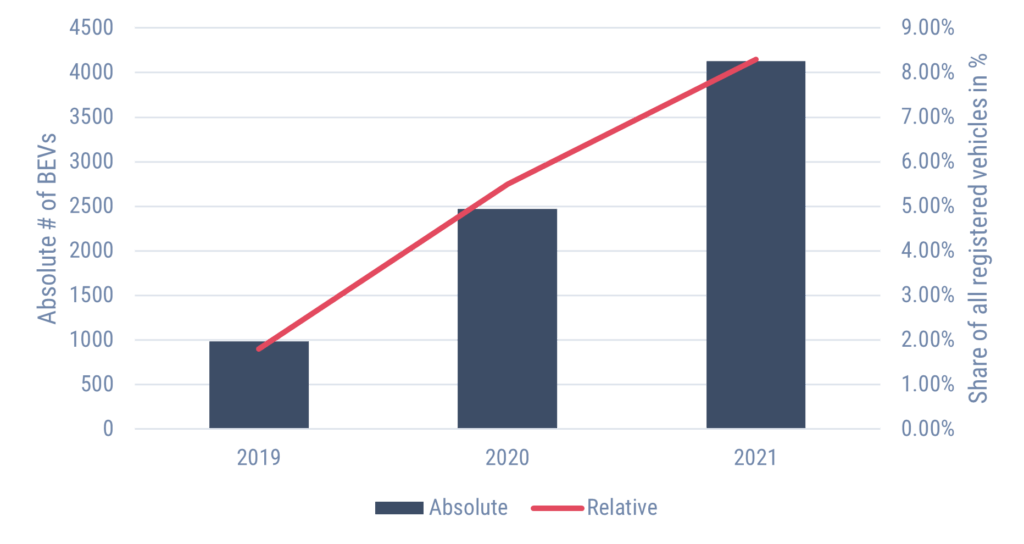
With the current growth rate, the vehicle composition on Luxembourg’s road network is sure to change swiftly (other categories in 2021: gasoline (37.4%), diesel (30.3%), and hybrid (24.1%)). In 2020, Norway, Iceland, and Sweden had a significantly higher penetration rate, with BEV and PHEV accounting for 74.8%, 45%, and 32.2%, respectively, compared to Luxembourg with 19.8%, and the European Union with 10.5%.
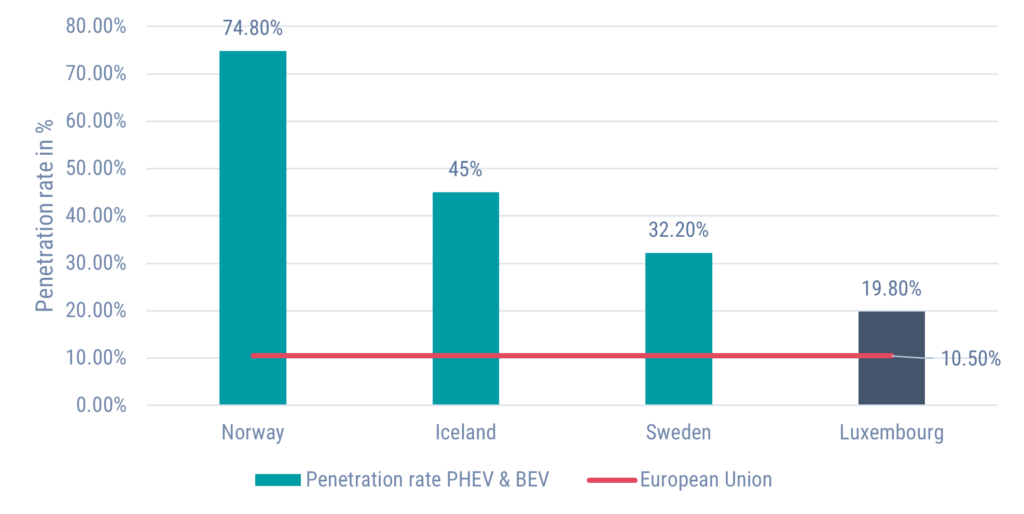
According to the European Alternative Fuels Observatory, by the end of 2020, 4032 BEVs and 4516 PHEVs were using the Luxemburgish roads. With around 950 public charging stations in Luxembourg, one can easily calculate a ratio of about eight plug-in electric vehicles per charging station.
In comparison to other European countries, Luxembourg is well-positioned.
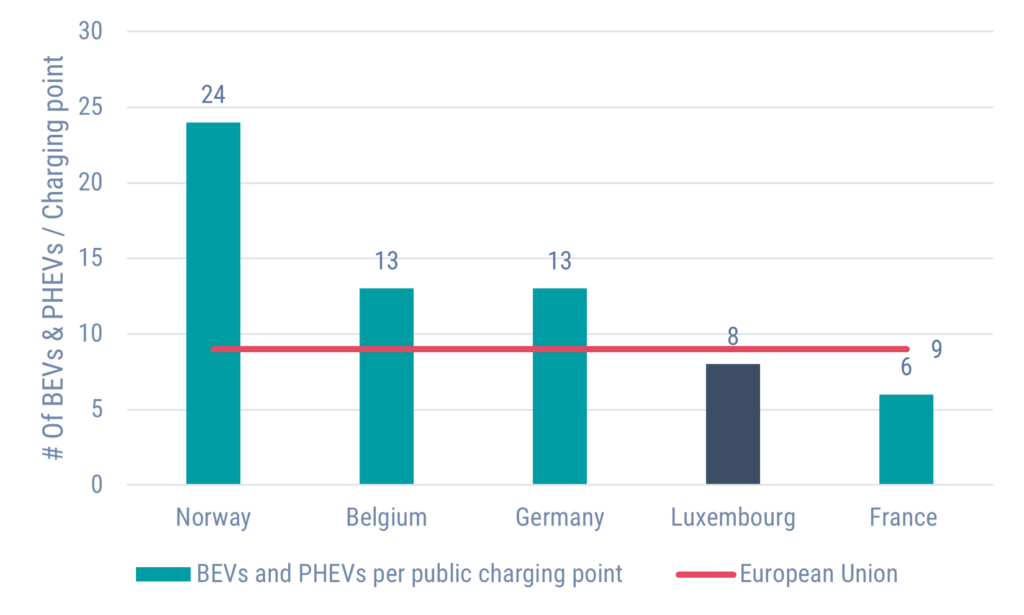
Based on these official statistics it cannot be argued that missing charging points in relation to the number of registered PHEVs and BEVs are the main reason for the relatively small number of alternatively motorized vehicles in Luxembourg.
Whoever was once interested in buying or leasing an electric car experienced the following situation: the car dealer or the leasing company highlighted the significant advantage of the BEVs’ lower energy costs compared to traditional combustion vehicles. In principle, you can lower your energy costs by roughly 50% by switching to a BEV. It’s pretty simple to do this kind of calculation based on the current market price of fuel (€1.2/l) and the average consumption of 6l/100 km, versus 17 kW/100 km at an energy price of €0.26/kWh at a public charging station in Luxembourg.
Luxembourg, however, is in a unique situation: thousands of Belgian, French, and German people are crossing the borders each day to commute to their workplaces. One of the sales arguments in the neighboring countries is that people can charge their cars for free at many public charging stations. In those countries, most free charging stations are located conveniently next to shops or even restaurants, and the number keeps increasing at a very high growth rate. In Luxembourg, according to chargemap.com, a community-based map service for finding charging stations, only a limited number of free charging stations are indicated. They are provided by private companies, car dealers and repair shops, or public organizations (e.g., ACL). However, access to the charging stations might be limited to opening hours or restricted to employees or clients.
In Luxembourg, the charging infrastructure is dominated by Chargy, a joint initiative of all network operators (Creos, Electris, Sudstroum, Ville de Diekirch, and Ville d’Ettelbruck). The ratio of free vs. paid charging stations appears to be much higher in the neighboring countries than in Luxembourg.
Calculating the costs of each kilometer traveled with a BEV or PHEV depends on the costs for charging. Besides public infrastructure, charging at home is definitively most used. The price for one kWh varies enormously in the three neighboring countries.
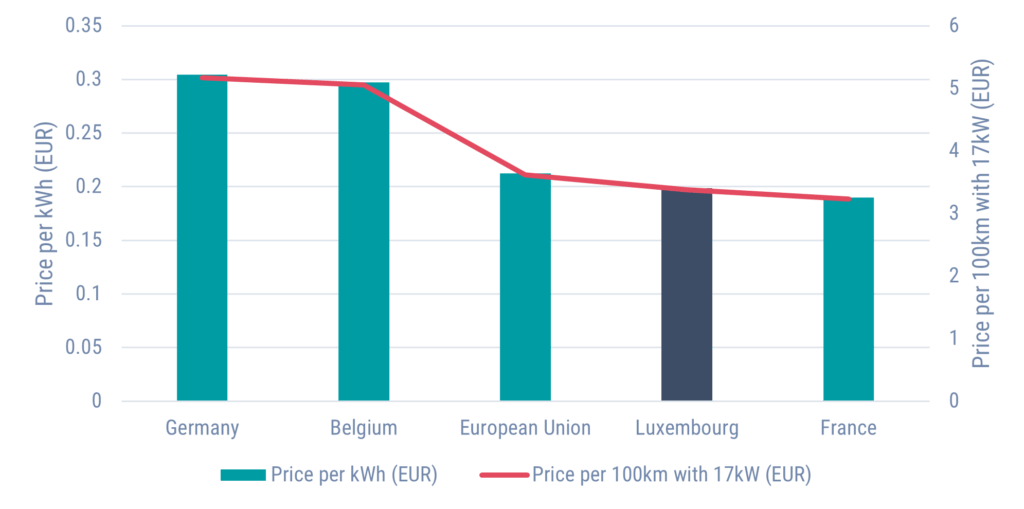
Driving an electric vehicle is different from gasoline- or diesel-powered ones: in terms of acceleration, but most important in planning your daily usage of your car, especially when it comes to charging. Charging connectors are providing different capacities. The Type 2 plug, a triple-phase plug, is the standard model in Europe and likewise Luxembourg. Most public charging stations provide up to 43 kW. Combination plugs, an enhanced version of the Type 2 plug, providing alternating and direct current charging power levels, can level up to 170 kW. The main difference between both is the time a vehicle needs to be fully charged.
Chargy power plugs have been in the past Type 2 connectors with a limited provided power level of 22 kW. Until 2023 this will change drastically with the new SuperChargy charging stations providing up to 320 kW. To give you an example: imagine, you just recently bought the new Volkswagen .ID3 Pure Performance with a 45 kWh battery capacity and a maximum 7.2 kW charging power. Today, with the most common charging plugs providing 22 kW, but it takes you over six hours to fully charge your car*. The Latest by 2023, you would charge your battery entirely at only a fraction of this: in under 9 minutes, you would be ready to go. Of course, vehicles would need to support such very high charging power levels. Compared to fueling your car, there is only a minimal difference.
The installation of DC-enabled plugs that support the maximum power available is still in the phase of deployment. In Luxembourg, most charging stations are Type 2 plugs.
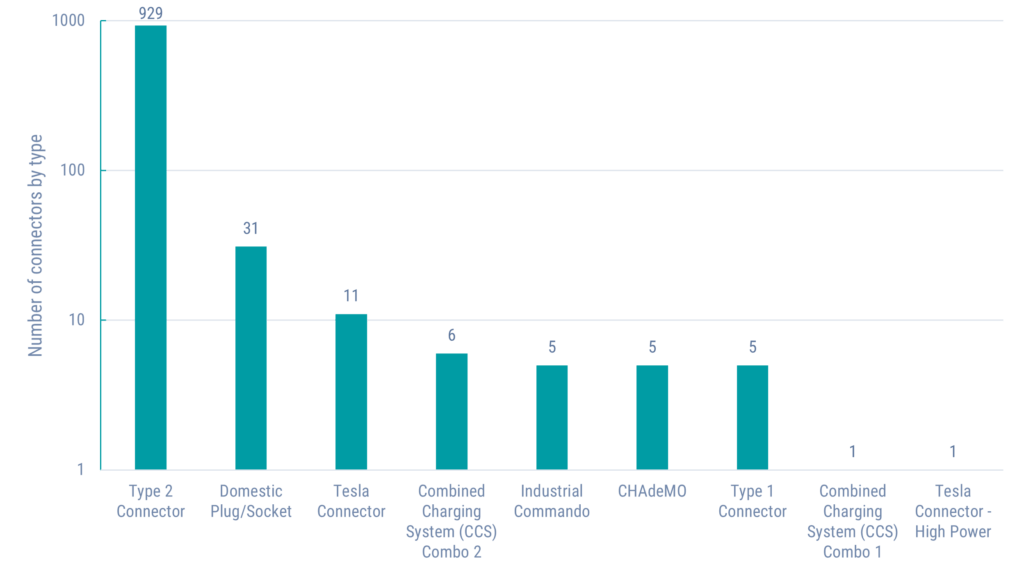
Only a few chargers with more than 50 kW are currently available in Luxembourg: in Mënsbech, Esch-sur-Alzette, Luxembourg, and Howald.
Side note: To better understand the following graphics and numbers, it’s helpful to explain the term median as it is often confused with the word average. In a sense, the median is what you usually mean when you say ‘the average man in the street’. The median is the middle-of-the-road number – half of the people are above the median, and half are below the median if you would sort the numbers in order (highest to lowest or lowest to highest) and then pick the middle number.

Aren’t there enough chargers in relation to the number of inhabitants? The City of Luxembourg, with currently more than 100 charging stations, only ranks in the last quartile. Knowing about the specific situation with many commuters heading daily to the capital, one can question if the city is adequately prepared. Compared with Norway’s capital Oslo, the leading country in the adoption of electrified vehicles: with 243311 inhabitants and 263 charging stations, it has a comparable ratio of approximately one charger per 1000 inhabitants to Luxembourg City.

So what’s the reality at the charging stations in Luxembourg City: are they always occupied, and BEV owners are queuing? Taking a look at the availability of charging stations during a typical weekday indicates that this is not really to be feared: more than 90% remain unused in the city. You can observe that other communes close to Luxembourg City, like Hesperange and Strassen, have higher occupancy levels of their chargers. In general, this shows that the available capacity in terms of chargers is not a bottleneck.
Remark: The availability data is provided by Here.com and aggregated by town. The high availability might be caused by the fact that many commuters still work remotely due to the COVID-19 pandemic situation.
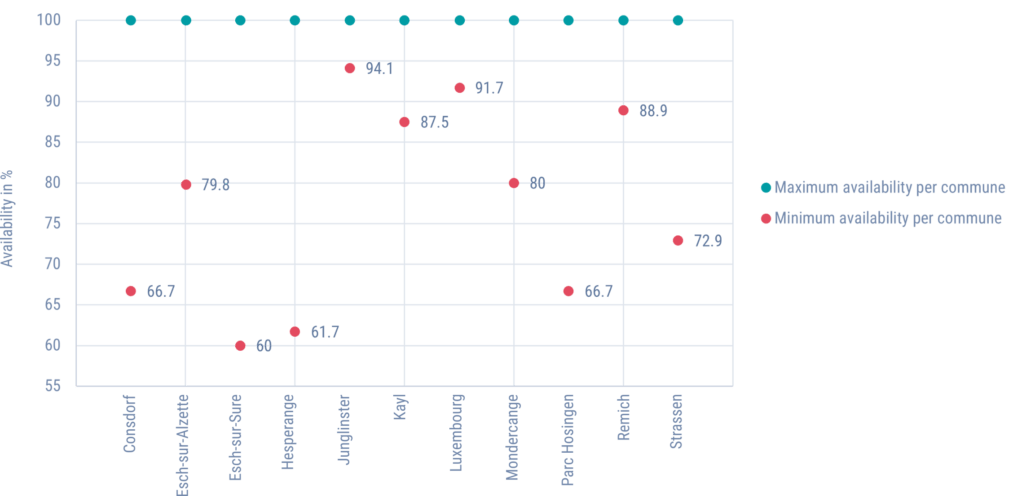
To answer the initial question if Luxembourg is well-positioned to help people to transition to electromobility: it’s in a good way. The situation with charging infrastructure is comparable to other reference countries in the EU. However, the alternatives for free charging are limited, which might condition users’ decision-making to switch to (plug-in) electric vehicles when the total cost of ownership is calculated considering the cost of purchase, energy, and fiscal advantages.
Providing a sufficient number of charging stations, adequately located in terms of general mobility patterns, at the necessary power level to allow fast charging, is a must for further mass adoption.
*Thanks to ACL for spotting the missing maximum charging power of the vehicle!
| Cookie | Duration | Description |
|---|---|---|
| cookielawinfo-checkbox-analytics | 11 months | This cookie is set by GDPR Cookie Consent plugin. The cookie is used to store the user consent for the cookies in the category "Analytics". |
| cookielawinfo-checkbox-functional | 11 months | The cookie is set by GDPR cookie consent to record the user consent for the cookies in the category "Functional". |
| cookielawinfo-checkbox-necessary | 11 months | This cookie is set by GDPR Cookie Consent plugin. The cookies is used to store the user consent for the cookies in the category "Necessary". |
| cookielawinfo-checkbox-others | 11 months | This cookie is set by GDPR Cookie Consent plugin. The cookie is used to store the user consent for the cookies in the category "Other. |
| cookielawinfo-checkbox-performance | 11 months | This cookie is set by GDPR Cookie Consent plugin. The cookie is used to store the user consent for the cookies in the category "Performance". |
| viewed_cookie_policy | 11 months | The cookie is set by the GDPR Cookie Consent plugin and is used to store whether or not user has consented to the use of cookies. It does not store any personal data. |
Test drive our API Suite for 30 days!
Tell us a bit about yourself, and we’ll get in touch with you in no time.